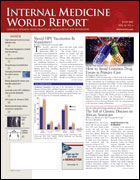Publication
Article
Internal Medicine World Report
Nonhormonal Drug Therapies Reduce Vasomotor Symptoms
Author(s):
FROM THE SOCIETY OF GENERAL INTERNAL MEDICINE
But Common Side Effects Persist
TORONTO—Women who wish to be treated for menopausal symptoms but are unable or unwilling to take estrogen represent a clinical challenge. Since the publication of the Women's Health Initiative, concerns about the adverse effects of hormone therapy have led to an increased interest in alternative treatments for menopausal symptoms.
Recent studies have documented the dose-dependent efficacy of some nonhormonal therapies for hot flashes, but these studies were small and of short duration, and the treatments studied generally were less effective than estrogen, said Jennifer R. Zebrack, MD, at the Society of General Internal Medicine annual meeting.
JAMA
A recent meta-analysis (. 2006;295:2057-2071) provides evidence that selective serotonin reuptake inhibitors (SSRIs), serotonin norepinephrine reuptake inhibitors (SNRIs), clonidine (Catapres), and gabapentin (Neurontin) can reduce the frequency of hot flashes by about 1 to 2 per day. By comparison, estrogen therapy has been shown to reduce the frequency by 2.5 to 3.0 per day, said Dr Zebrack, associate professor of general internal medicine, University of Nevada, Reno.
However, side effects are common with the nonhormonal alternatives, "so you may be substituting one symptom for another, especially at higher doses," she said.
In general, discussing potential side effects with the patient and starting with the lowest dose of the chosen agent is prudent, she advised. "I individualize the choice based on personal risks, preferences, the severity of symptoms, and other chronic conditions," she said. "For example, I may pick an antidepressant in a woman who also has mood disorder or gabapentin in a woman with chronic pain issues."
Although there are no head-to-head studies of SSRIs, data suggest that paroxetine (Paxil) and venlafaxine (Effexor) may be more effective than other agents in this class (Table).
Table. Trial results of nonhormonal therapies for hot flashes
Therapy
RCT trials reviewed
Trial quality
Trials included in meta-analysis
Mean difference in daily hot flashes vs placebo (95% CI)
Severity or composite score (% difference)
SSRIs or
SNRIs
6
Fair-good
7
–1.13 (–1.7 to –0.57)
Improved in 4/6 trials
(10-30)
Clonidine
10
Poor-fair
4 at 4 wks
2 at 8 wks
–0.95 (–1.44 to –0.47)
–1.63 (–2.76 to –0.05)
Improved in 4/7 trials
(13-26)
Gabapentin
2
Fair-good
2
–2.05 (–2.80 to –1.30)
Improved in 2/2 trials
(23-30)
Red clover
isoflavone
6
Poor-good
8
–0.44 (–1.47 to 0.58)
No difference
Soy
isoflavone
11
Poor-fair
5 at 4-6 wks
4 at 12-16 wks
2 at 6 months
–1.15 (–2.33 to 0.03)
–0.97 (–1.82 to –0.12)
–1.22 (–2.02 to –0.42)
Improved in
3/7 trials
RCT = randomized controlled trial.
JAMA
Adapted from Nelson HD, et al. Nonhormonal therapies for menopausal hot flashes:systematic review and meta-analysis. . 2006;295:2057-2071.
P
Among the studies rated as "good" quality in the meta-analysis was one placebo-controlled trial of paroxetine CR, 12.5 or 25 mg/day. Active therapy reduced hot flashes by 1.4 to 1.6 per day compared with placebo ( = .01), but side effects were more common at the higher dose.
Three doses of venlafaxine XR (37.5, 75, or 150 mg/d) were compared with placebo in breast cancer survivors in a "good-quality" study included in the meta-analysis. Pooling the results from the groups randomized to venlafaxine XR demonstrated a reduction in hot flash frequency of 2.2 per day versus placebo, with better efficacy at higher doses, but at a cost of more side effects.
The composite score (frequency X severity of hot flashes) was improved with either SSRI.
Clonidine was also found to reduce daily hot flash frequency and composite score in 4 clinical trials (3 rated as "fair" and 1 rated as "poor" quality) using mostly 0.1 mg/day. The women treated with clonidine, however, experienced dry mouth and dizziness more often than the placebo recipients.
JAMA
P
Clonidine or gabapentin may be better options in women who are taking tamoxifen (Soltamox), because tamoxifen may interact with SSRIs. One "good quality" study of gabapentin (100 or 300 mg 3 times daily) in the meta-analysis was conducted in breast cancer survivors. The higher dose reduced hot flashes by 2.1 per day compared with placebo ( <.001).
P
P
In a study of 60 women who had at least 50/week moderate-to-severe hot flashes for more than 2 months, participants were randomized to conjugated estrogen, gabapentin titrated to 800 mg 3 times daily, or placebo. Gabapentin performed as well as estrogen in reducing the frequency and severity of hot flashes. Compared with placebo, the composite score was reduced by 72% with estrogen ( =.016) and by 71% with gabapentin ( = .004). However, once again, there were more somatic complaints (eg, dizziness, headache) in the women randomized to gabapentin compared with estrogen or placebo.






